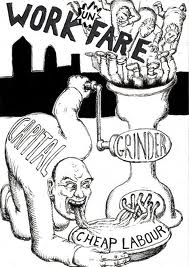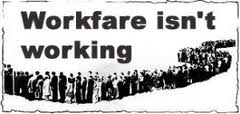The UK Government’s controversial Back to Work programme, deemed workfare by critics, received a bloody nose this week as all but one of the WorkFare schemes were found to compel a person’s labour and deemed illegal by the Court of Appeal at the Royal Courts of Justice. Though not an ultimate victory, this ruling sends a clear signal to the UK government that the public might not be willing to surrender their social contract without a fight after all.
What is Workfare?
The Government has a whole host of programmes purportedly in place to support the jobless back into paid employment. Workfare refers to all of the programmes which are mandatory, long term and paid less than minimum wage.
For example, offering an unemployed 21 year old History graduate 2 weeks work experience with the British Museum, at their request – is quite a different proposition from forcing the same 21 year old into 8 weeks stacking shelves at Tesco under threat of sanction.
The Government’s Work Experience Programme, Sector Based Work Academies, Community Action Programme, Mandatory Work Activity scheme and The Work Programme all fall into this category.
The Workfare Programme was first rolled out in a concerted way by New Labour.
In New Labour’s New Deal, long term unemployed people underwent a compulsory ‘intensified job search’. If the intensified job search period lasting up to four months proved unsuccessful, participants entered the second stage of the programme and are offered one of four options: full-time education or training for twelve months, a job with the voluntary sector for 6 months, work for the environmental task force for six months, or subsidised employment for six months with provision of employer on-the-job training. This last option is sometimes made available to people before the end of the ‘Gateway’ period.
On the first three options, individuals continue to receive the equivalent of Job Seekers Allowance (unemployment benefit). In addition, for working in the voluntary sector or on the environmental task force they receive an extra £400 spread over the six months. The value of the employer subsidy is £60 per week and employers receive an additional £750 to cover the costs of training they are supposed to provide.
In 2011, the Conservative and Liberal Democrat coalition government announced a plan to increase uptake of Workfare by 100,000. They also made changes to the programme as follows:
1. A jobseeker who leaves a placement after 1 week loses their welfare payments for 6 weeks. If they do this a second time, they lose them for 13 weeks. The third time, three years.
2. Placements can be mandated for up to 30 hours a week for as long as 6 months.
3. The scheme has been opened up so corporations in the private sector can exploit this taxpayer funded, forced labour.
This means that someone who finds themselves unemployed must work up to thirty hours a week, for up to six months at a time, stacking shelves for Tesco or Poundland simply to receive as little as £53 per week, which they are already entitled to as part of the social contract of Britain. Also, Tesco isn’t paying the £53; we are, through our taxes.
Although an interview is supposed to be guaranteed at the end of the term, it is not required that the workfare provider has a vacancy open. An interview for a job that doesn’t exist is no interview at all.
Corporations get free labour, the government gets to massage the unemployment figures (Workfare victims are counted as employed) and the unemployed, (of which there are 3 million in the UK today) get shafted.
The Three Main Arguments Against Workfare
Firstly, as a society, we have agreed that forced labour is against the law. Article 4 of the European Convention of Human Rights clearly states – No one shall be required to perform forced or compulsory labour. If the government threatens to withdraw a person’s sole lifeline, lest they supply their labour, then it can clearly be argued that this labour has been attained forcibly. The labour is also clearly compulsory.
Secondly, the opening of the scheme to the private sector, allowing public funding of private labour simply beggars belief. It is completely unconscionable to many, that whilst the government is taking a chainsaw to the welfare state on the stated grounds of ‘austerity’– it chooses to use taxpayers’ money to fund forced labour for private corporations. Aside from being principally abhorrent in and of itself, there are a series of undesirable outcomes. It means corporations get to choose between salaried and free staff, creating competition with the ‘real’ jobs market and a further means of suppressing wages in the real economy. It also means that Topshop owner Arcadia (an infamous tax avoider) gets free staff paid for by taxes they themselves refuse to pay.
Thirdly, it entirely subverts the minimum wage. We agreed as a society, that we needed a minimum wage in order to provide a balance between a corporation’s logical ambition to reduce its labour costs and a workers need to gain a fair, living wage. Before and since the implementation of the minimum wage, corporations have battled against this legislation, arguing they need to be freed of this ‘red tape’ in order to compete and grow their business. This policy allows corporations not only to avoid paying a minimum wage, but no wage at all.
How Did it End up in Court?
Cait Reilly and Jamieson Wilson took the Department of Work and Pensions to court after finding themselves victims of workfare.
University graduate Reilly was told by her job centre in November 2011 that she had to spend two weeks stacking shelves and cleaning floors at Poundland for free or she would lose her Job Seekers Allowance. At the time, Reilly was volunteering at her local museum gaining important work experience within her chosen vocation and had to leave her placement to conduct this free labour for Poundland. Ironically, this workfare scheme was called the #sector based work academy’. Speaking on the experience Reilly said:
“The experience did not help me get a job. I wasn’t given any training and I was left with no time to do my voluntary work or search for other jobs…The only beneficiary was Poundland, a multimillion-pound company. Later I found out that I should never have been told the placement was compulsory…I don’t think I am above working in shops like Poundland. I now work part time in a supermarket. It is just that I expect to get paid for working.”
Jamieson Wilson is an unemployed HGV driver who was required to clean furniture for 30 hours a week for six months under the governments Community Action Programme. On refusing to provide his labour for no wage, Wilson was sanctioned by having his Job Seekers Allowance revoked for six months.
Public Interest Lawyers took up the cases of the two and the first success came at the Court of Appeal of the Royal Court of Justice this week.
The Verdict
In a unanimous decision, three judges from the Court of Appeal have today ruled that the Regulations[1][1] under which most of the Government’s “Back to Work” schemes have been created are unlawful and must be quashed.
In Reilly’s case, the courts found that she should not have been informed that the scheme was mandatory, when instead she should have been able to refuse. Wilson was found to have not been informed clearly enough that he would lose his social security payments for six months if he refused his placement.
The ruling saw a swathe of the governments workfare programmes ended. From today, the tens of thousands of UK citizens undergoing the Work Programme, Sector Based Work Academies, Community Action Programme and other schemes can leave their placements and all sanctions in place must be rescinded.
This is no small result for the Boycott Workfare campaign and their supporters. The campaign has used a mixture of direct actions (attending premises of corporations and charities who use workfare labour), online actions such as petitions and twitter mobbing, and now legal battles to confront the spectre of forced labour via workfare.
Tessa Gregory, Solicitor for Reilly & Wilson told the Press Association:
“Today’s judgment sends Iain Duncan Smith back to the drawing board to make fresh regulations which are fair and comply with the court’s ruling.
Until that time nobody can be lawfully forced to participate in schemes affected such as the Work Programme and the Community Action Programme.
All of those who have been stripped of their benefits have a right to claim the money back that has been unlawfully taken away from them.”
The result has been greeted warmly but cautiously by those campaigning against Workfare. The ruling succeeded, but on very narrow grounds which leaves the Mandatory Work Activity programme in place.
The most unfortunate section of the ruling states that government is welcome to develop such schemes as “are designed to assist the unemployed to obtain employment”, and that it is “equally entitled to encourage participation in such schemes by imposing sanctions.” This does give the Department of Work and Pensions wiggle room to centre its efforts on dreaming up new and ever more dastardly means of compelling the nations labour.
So whilst the ruling allows for those 17,000 people compelled into Workfare between November 2011 and May 2012 alone, to make similar cases and have their benefits compensated accordingly – it is by no means the death knell for Workfare.
What Now?
The Boycott Workfare Campaign has announced a UK wide week of action 18th-24th March 2013 with the aim of bringing the final remaining workfare scheme, Mandatory Work Activity, to an end. Pressure to date has seen more than 17 providers including TK Maxx, Burger King and Body Shop withdraw from the scheme. Despite the notably lacklustre media response to the verdict, it is important that we take a moment to acknowledge successes when they come. The battle to protect our right to a fair day’s wage for a day’s work will not be won overnight, but each victory reassures us ultimate victory is possible. Today, we are significant steps closer to ending the schemes once and for all. It is on all of us to get involved today and make a stand as human beings to uphold this basic right, earned for us by workers past.
Visit Boycott Workfare now to see how you can support the campaign.







[…] said in 2010, that the NHS would be privatised, secret courts would be introduced, people would be forced to work full time for corporations in order to receive their social security payments, or that 10,600 sick or disabled people would die each year within weeks of having their benefits […]
[…] won’t retell the story of workfare and the court case here, but for the background please see this previous post. What concerns us now is the government’s reaction. The verdict, while on narrow grounds, […]
[…] won’t retell the story of workfare and the court case here, but for the background please see this previous post. What concerns us now is the government’s reaction. The verdict, while on narrow grounds, […]
[…] Two victims of Workfare took the UK government to court over the scheme and the Court of Appeal found in their favour. […]
Great article. Regarding the goverments job site universl jobmatch and it potentially being mandatory for the unemployed. how can the site ever be mandatory for the unemployed? As it requires cookies to use it, and to force cookies on a persons computer is illegal. it also goes against the 1998 data protection act.
Great article, nice to have all the facts so clearly conveyed without excessive anti-government invective confusing the issue. Whilst I often enjoy such invective, some bloggers are prematurely claiming the end of workfare when we are patently not there yet. However this ruling is very encouraging and will hopefully inspire more people to join the resistance. Loving your blog posts, keep them coming 🙂
Hey Josie, thanks for reading and that lovely comment. Yes, it is important to a) acknowledge success and b) be realistic about how far we have yet to go. We’ll get them in the end! 😉 I’ll keep the blogs coming for as long as you can keep reading them! 😉
There are people who are workshy; there are people who are actually too indecisive to go and get a job. These few people might be helped by a kick up the bum like workfare. These few would not cause a downward pressure on wages; and these few might even end up grateful. The majority affected however are being trampled roughshod in another attempt by this government to give their donors more profit. I have yet to see any of these types of schemes help more than a very few unemployed people and that is going back 30 plus years.
Mark Lawson